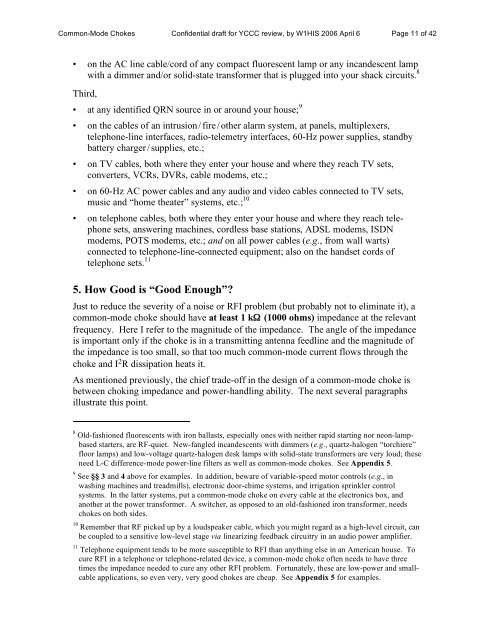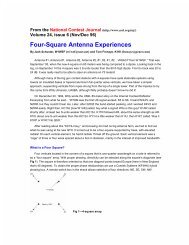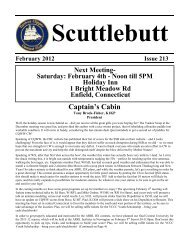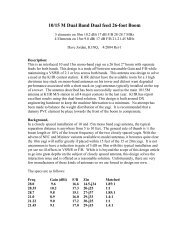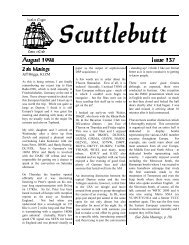Common Mode Chokes by W1HIS - Yankee Clipper Contest Club
Common Mode Chokes by W1HIS - Yankee Clipper Contest Club
Common Mode Chokes by W1HIS - Yankee Clipper Contest Club
You also want an ePaper? Increase the reach of your titles
YUMPU automatically turns print PDFs into web optimized ePapers that Google loves.
<strong>Common</strong>-<strong>Mode</strong> <strong>Chokes</strong> Confidential draft for YCCC review, <strong>by</strong> <strong>W1HIS</strong> 2006 April 6 Page 11 of 42• on the AC line cable/cord of any compact fluorescent lamp or any incandescent lampwith a dimmer and/or solid-state transformer that is plugged into your shack circuits. 8Third,• at any identified QRN source in or around your house; 9• on the cables of an intrusion / fire / other alarm system, at panels, multiplexers,telephone-line interfaces, radio-telemetry interfaces, 60-Hz power supplies, stand<strong>by</strong>battery charger / supplies, etc.;• on TV cables, both where they enter your house and where they reach TV sets,converters, VCRs, DVRs, cable modems, etc.;• on 60-Hz AC power cables and any audio and video cables connected to TV sets,music and “home theater” systems, etc.; 10• on telephone cables, both where they enter your house and where they reach telephonesets, answering machines, cordless base stations, ADSL modems, ISDNmodems, POTS modems, etc.; and on all power cables (e.g., from wall warts)connected to telephone-line-connected equipment; also on the handset cords oftelephone sets. 115. How Good is “Good Enough”?Just to reduce the severity of a noise or RFI problem (but probably not to eliminate it), acommon-mode choke should have at least 1 kΩ (1000 ohms) impedance at the relevantfrequency. Here I refer to the magnitude of the impedance. The angle of the impedanceis important only if the choke is in a transmitting antenna feedline and the magnitude ofthe impedance is too small, so that too much common-mode current flows through thechoke and I 2 R dissipation heats it.As mentioned previously, the chief trade-off in the design of a common-mode choke isbetween choking impedance and power-handling ability. The next several paragraphsillustrate this point.8 Old-fashioned fluorescents with iron ballasts, especially ones with neither rapid starting nor neon-lampbasedstarters, are RF-quiet. New-fangled incandescents with dimmers (e.g., quartz-halogen “torchiere”floor lamps) and low-voltage quartz-halogen desk lamps with solid-state transformers are very loud; theseneed L-C difference-mode power-line filters as well as common-mode chokes. See Appendix 5.9 See §§ 3 and 4 above for examples. In addition, beware of variable-speed motor controls (e.g., inwashing machines and treadmills), electronic door-chime systems, and irrigation sprinkler controlsystems. In the latter systems, put a common-mode choke on every cable at the electronics box, andanother at the power transformer. A switcher, as opposed to an old-fashioned iron transformer, needschokes on both sides.10 Remember that RF picked up <strong>by</strong> a loudspeaker cable, which you might regard as a high-level circuit, canbe coupled to a sensitive low-level stage via linearizing feedback circuitry in an audio power amplifier.11 Telephone equipment tends to be more susceptible to RFI than anything else in an American house. Tocure RFI in a telephone or telephone-related device, a common-mode choke often needs to have threetimes the impedance needed to cure any other RFI problem. Fortunately, these are low-power and smallcableapplications, so even very, very good chokes are cheap. See Appendix 5 for examples.


